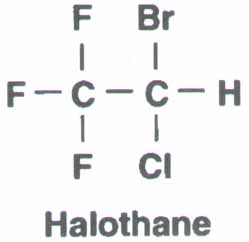Inhalational Anesthetic Agents
Halothane, CF3-CHBrCl

Introduced in 1956, our most cost-effective inhalational agent.
Physical Properties
- halogenated ethrane
- vapor pressure = 243 mmHg at 20 deg C
- spontaneous oxidative decomposition retarded by
- thymol preservative
- amber-colored bottle
- least expensive volatile anesthetic agent
Organ System Effects
Cardiovascular- direct myocardial depressant and coronary artery vasodilator
- interfers with Na-Ca exchange and
- intracellular Ca utilization
- depresses cardiac output and lowers arterial BP
- depresses myocardial O2 demand so that
- myocardial O2 delivery is adequate
- depresses SA-node function
- bradycardia
- AV nodal rhythm
- depresses baroreflex
- enhances myocardial sensitivity to the dysrhythmogenic effects of epinephrine
- limit epi to < 1.5 mcg/kg
- fast, shallow breathing, with
- increased paCO2 (during spontaneous ventilation) that
- partly reverses cardiovascular depression
- severe depression of hypoxic ventilatory drive (even at 0.1 MAC)
- potent bronchodilator (inhibits intracellular Ca mobilization)
- depresses mucocilliary function
- general anesthesia, MAC = 0.75
- cerebral vasodilator
- increases CBF
- blunts cerebrovascular autoregulation
- hyperventilation prior to halothane may prevent the expected rise in ICP
Biotransformation and Toxicity
- oxidized in liver by cytochrome P-450 2EI to trifluroacetic acid
- absent O2, hepatotoxic reduction products may arise
- halothane hepatitis
- extremely rare (1:35,000 cases)
- factors that increase risk:
- multiple exposures to halothane over a short interval
- middle-aged, obese women
- familial predisposition
- personal history of toxicity
- centrilobular necrosis
- antibody that binds to halothane-exposed hepatocytes may be isolated
Contraindications/Precautions
- malignant hyperthermia susceptibility
- unexplained liver dysfunction after previous halothane exposure
- intracranial mass lesion
- hypovolemia
- aortic stenosis
- pheochromocytoma
- with aminophylline has been associated with severe ventricular dysrhythmias